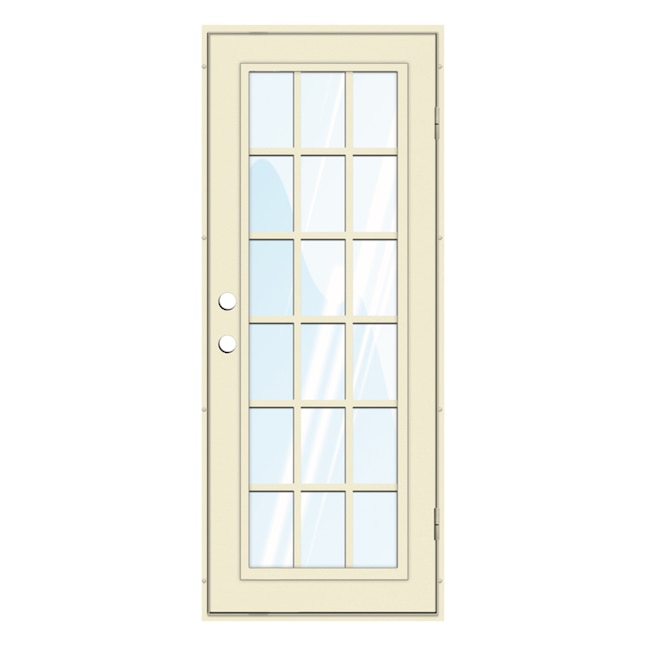
Installing secure storm doors on your home is a great way to secure your home and keep out unwanted visitors. These doors are made out of steel, so it is difficult for anyone to break in. You can fit them with any locking system you choose, including deadbolts. Not only are these doors great for protecting the front of your home, but they can also protect the back door and garage door.
Durability
It is crucial to assess how durable Security Storm Doors are before you purchase them. Some of these doors have higher durability than others. For example, some of the most durable ones use bank vault-like deadbolt pins and heavy-duty keyed locks. Others secure models come with hinges that can't be removed. Many models use aluminum skins or plastic frames. Nevertheless, there are significant differences between different models. The hinge warranty may also be worth looking into.
Another benefit of secure storm doors is their energy efficiency. They have three layers: a layer of aluminum skin on the front and back, along with foam insulation in their center. This makes your home warmer and more comfortable in the winter, and cooler in the summer. These glass blocks out the outside weather, so it doesn't come into your home. Low-E glass may be available for models that increase efficiency and protect you from harmful UV rays.
Energy efficiency
Energy efficiency is an important component of home improvements. Storm doors could play a significant part in this. These doors keep cold outside air out while keeping warm inside. This protects your home from any damage caused by inclement weather. This reduces your energy bills. Storm doors can also be equipped with screens.

These doors are usually made from low-E safety glass but can also be made with other materials. Low-E glass has superior insulation and energy efficiency. Some varieties even come with UV-resistant glasses.
Security
Storm doors are a great way for protecting your home from burglary. They are made from heavy-gauge, steel with an additional panel of glazing to deter intruders. A number of models include a security screen door to increase security. These doors can be fitted as a deadbolt or with another locking mechanism.
Security storm doors are not only an effective way to increase the security of your home, but they are also attractive. These doors can be made of various materials and can come in many different designs and styles.
Cost
Secure storm doors can be expensive. While some models are inexpensive and include security features, others can cost up to $1,000. These types of doors allow you to rest easy knowing that your home has been secured from intruders. You can choose from full or retractable glass panels, and there are many styles and materials available for security storm doors. They come with a 10-year limited warranty.
The price of a storm-door security system will vary depending on its size and construction material. The average security storm door will cost between $100 and $400, while a more secure one will cost from $300 to $3,000.

Installation
You need to carefully measure the storm door before you install it. Measure the opening from top of the frame to threshold before purchasing a storm doors. Measure the opening from the top of your frame to the threshold in three locations: in center, left and right. Storm doors should have enough room between the frame and door panel to allow for seasonal expansion/contraction. You will receive specific recommendations from the manufacturer. Next, place the door in the opening. Check that it fits. To make the door more level, add wood blocks.
Steel security storm door are a great option for homeowners who want to block unauthorized access through screens but still allow natural light into their homes. These doors are resistant to wind damage, and they prevent glass from shattering. This will allow you to enjoy the sunshine and fresh air without worrying that burglars might break in.
FAQ
Which home alarm system features are the best?
Ring Video Doorbell Pro boasts the most features among all of the home security systems we evaluated. It allows you to see who is at the door, chat with them, and even record videos. You can also save recordings to the cloud with this free service.
What is your number one home security product?
Ring Video Doorbell Pro is our number one home alarm system. It allows you to see and speak to anyone at anytime from anywhere using your smartphone. You can also capture video and send it to family and friends by text message or email.
Do motion sensors have alarms
There have been motion sensor alarm systems for decades. They have grown in popularity due to increasing burglaries and thefts. These alarms are too costly and won't work in cabinets. A motion sensor alarm system can be a great way to protect your home against intruders.
What is the best security system to install?
The best security system to install depends on how much you value your home and belongings. A basic alarm system is a good option, but it doesn't provide enough protection. You can go with a basic alarm system that provides limited protection, but you have the option to upgrade to one that has remote monitoring and video surveillance as well as access control.
Can I install my own security camera?
Yes! If you are competent and have the right knowledge, you can install your own home alarm. If you don't want to do it yourself, then hire an expert who will be able to help you install it properly.
What is the highest rated home security system?
ADT Pulse (Ring Alarm), Vivint SmartHome Security, Protect America, and Vivint SmartHome Security are the most well-known home security systems.
Statistics
- That's probably why Cove has a whopping 98%* customer retention rate. (safewise.com)
- Depending on your insurance, 24/7 professional monitoring may qualify you for as much as 15% off your premium. (safewise.com)
- Cove sets you free without punishing penalties and fees, unlike other security solutions that charge 75% to 100% of your remaining contract. (safewise.com)
- Depending on your insurance, 24/7 professional monitoring may qualify you for as much as 15% off your premium. (safewise.com)
External Links
How To
How to Install A Home Security System
A home alarm system is a device which monitors your home and alerts when there's an activity. It could be a motion detector, doorbell camera or smoke detector. A home security system is usually composed of one or several sensors (e.g. motion detectors), that send signals when there's movement or sound. The signals are then sent over to a control box where they are monitored and recorded. If there's a problem such as someone breaking into your house or other suspicious activity, the control panel sends an alert via your phone, tablet computer, voice assistant, or computer. The control panel will notify you immediately so that you can take corrective action.
Selecting the right sensors for your home is an important step in installing a home security alarm system. There are two main types of sensors: passive and active. Passive sensors don’t require batteries. They only pick up sounds, vibrations and other signals from their environment. These sensors include sirens, buzzers, and doorbells. Active sensors use electricity to transmit data. These sensors include motion sensors and cameras.
There are many sensors brands today. Each brand has its pros and cons. For instance, some sensors can be weatherproof while others don't. Some include built-in speakers to allow you hear them even when they are outside. Others work only inside. Some have simple features, while others provide advanced features like night vision.
After choosing the best sensor type for your property you can choose a manufacturer. This will help ensure that your sensors work well together. The hardware store should offer many choices.
After you have chosen a brand, you will need to decide how many sensors you wish to purchase. Depending on whether someone lives alone or with their family, most people buy one to two sensors. You might want to buy more sensors if you intend on adding them later.
Next, you'll need to figure out where you want to place your sensors. Do you want them near windows and doors? Or would you rather have them hidden? Make sure you get permission before placing them around your property. It is important to ensure they do not interfere with electrical outlets.
Now that you know where you want to put your sensors, you'll need a way to connect them to your control panel. You may need a power adapter, or battery pack depending on the setup. Once everything is in place, you can start to monitor your property.